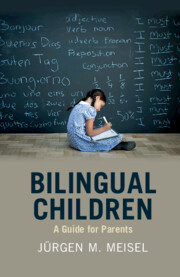Book contents
- Bilingual Children
- Bilingual Children
- Copyright page
- Dedication
- Contents
- Preface
- Abbreviations
- 1 Bilingualism in Early Childhood
- 2 How Infants Become Native Speakers
- 3 Two Languages in One Mind
- 4 Keeping Languages Apart
- 5 Language Dominance
- 6 Trilingual and More
- 7 The Age Question
- 8 Benefits and Advantages of Child Bilingualism
- Bibliography
- Index
- References
2 - How Infants Become Native Speakers
Published online by Cambridge University Press: 08 June 2019
- Bilingual Children
- Bilingual Children
- Copyright page
- Dedication
- Contents
- Preface
- Abbreviations
- 1 Bilingualism in Early Childhood
- 2 How Infants Become Native Speakers
- 3 Two Languages in One Mind
- 4 Keeping Languages Apart
- 5 Language Dominance
- 6 Trilingual and More
- 7 The Age Question
- 8 Benefits and Advantages of Child Bilingualism
- Bibliography
- Index
- References
Summary
Parents often wonder whether children acquiring two languages simultaneously will attain native competences in both. In order to answert this question, we must contrast bilinguals’ language development with that of monolinguals. This requires a basic understanding of monolingual first language (L1) acquisition: It is always successful, happens at a fast rate and uniformly in that children proceed through identical developmental phases. These properties can be explained if we assume that L1 acquisition is guided by an innate Language Making Capacity (LMC), comprising general-purpose and language-specific cognitive principles. The latter make up the The Language Acquisition Device (LAD). Unversal Grammar (UG), a subcomponent of the LAD, consists of principles specifying formal properties of human languages. The simultaneous acquisition of two languages from birth exhibits the same properties as L1 development. Developmental sequences are non-distinct in bilinguals and monolinguals, and bilingual development happens at appproximately the same rate. It can thus indeed be qualified as bilingual first language acquisition.
Keywords
- Type
- Chapter
- Information
- Bilingual ChildrenA Parents' Guide, pp. 28 - 57Publisher: Cambridge University PressPrint publication year: 2019

